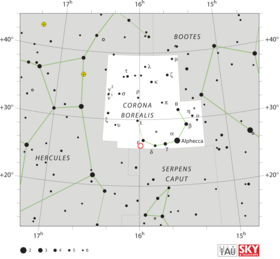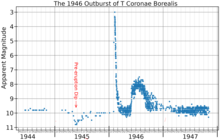This is an old revision of this page, as edited by Pygos (talk | contribs) at 09:43, 30 July 2024 (reworded). The present address (URL) is a permanent link to this revision, which may differ significantly from the current revision.
Revision as of 09:43, 30 July 2024 by Pygos (talk | contribs) (reworded)(diff) ← Previous revision | Latest revision (diff) | Newer revision → (diff) Recurrent nova in the constellation Corona BorealisNot to be confused with Tau Coronae Borealis.
 Location of T Coronae Borealis (circled in red)
Location of T Coronae Borealis (circled in red) | |
| Observation data Epoch J2000 Equinox J2000 | |
|---|---|
| Constellation | Corona Borealis |
| Right ascension | 15 59 30.1622 |
| Declination | 25° 55′ 12.613″ |
| Apparent magnitude (V) | 2.0–10.8 |
| Characteristics | |
| Evolutionary stage | Red giant + white dwarf |
| Spectral type | M3III+p |
| Variable type | recurrent nova |
| Astrometry | |
| Radial velocity (Rv) | −27.79 km/s |
| Proper motion (μ) | RA: −4.220 mas/yr Dec.: 12.364 mas/yr |
| Parallax (π) | 1.2127 ± 0.0488 mas |
| Distance | 806 pc (2,630 ly) ly |
| Orbit | |
| Period (P) | 227.55 d |
| Semi-major axis (a) | 0.54 AU |
| Eccentricity (e) | 0.0 |
| Inclination (i) | 67° |
| Details | |
| Red giant | |
| Mass | 1.12 M☉ |
| Radius | 75 R☉ |
| Luminosity | 655 L☉ |
| Surface gravity (log g) | 2.0 cgs |
| Temperature | 3,600 K |
| White dwarf | |
| Mass | 1.37 M☉ |
| Luminosity | ~100 L☉ |
| Other designations | |
| BD+26° 2765, HD 143454, HIP 78322, SAO 84129, 2MASS J15593015+2555126 | |
| Database references | |
| SIMBAD | data |
T Coronae Borealis (T CrB), nicknamed the Blaze Star, is a recurrent nova in the constellation Corona Borealis. It was first discovered in outburst in 1866 by John Birmingham, though it had been observed earlier as a 10th magnitude star. It may have been observed in 1217 and in 1787 as well. It is expected to undergo an outburst again very soon; it could erupt again before August 2024.
Description

T CrB normally has a magnitude of about 10, which is near the limit of typical binoculars. Well documented outbursts have been seen twice, reaching magnitude 2.0 on May 12, 1866 and magnitude 3.0 on February 9, 1946, though a more recent paper shows the 1866 outburst with a possible peak range of magnitude 2.5 ± 0.5. Even when at peak magnitude of 2.5, this recurrent nova is dimmer than about 120 stars in the night sky. It is sometimes nicknamed the Blaze Star.

T CrB is a binary system containing a large cool component and a smaller hot component. The cool component is a red giant that transfers material to the hot component. The hot component is a white dwarf surrounded by an accretion disc, all hidden inside a dense cloud of material from the red giant. When the system is quiescent, the red giant dominates the visible light output and the system appears as an M3 giant. The hot component contributes some emission and dominates the ultraviolet output. During outbursts, the transfer of material to the hot component increases greatly, the hot component expands, and the luminosity of the system increases.

The two components of the system orbit each other about every 228 days. The orbit is almost circular and is inclined at an angle of 67°. The stars are separated by 0.54 AU.
2016–present activity
On 20 April 2016, the Sky & Telescope website reported a sustained brightening since February 2015 from magnitude 10.5 to about 9.2. A similar event was reported in 1938, followed by another outburst in 1946. By June 2018, the star had dimmed slightly but still remained at an unusually high level of activity. By mid-2023, it faded by 0.35 magnitude; the lowest brightness seen since 2016. A similar dimming occurred in the year before the 1946 outburst, indicating an eruption before September 2024.
On July 30, 2024, T CrB has undergone a nova explosion.
References
- ^ Gaia Collaboration; et al. (November 2016). "Gaia Data Release 1. Summary of the astrometric, photometric, and survey properties". Astronomy & Astrophysics. 595: 23. arXiv:1609.04172. Bibcode:2016A&A...595A...2G. doi:10.1051/0004-6361/201629512. S2CID 1828208. A2.
- ^ Samus, N. N.; Durlevich, O. V.; et al. (2009). "VizieR Online Data Catalog: General Catalogue of Variable Stars (Samus+ 2007-2013)". VizieR On-line Data Catalog: B/GCVS. Originally Published in: 2009yCat....102025S. 1. Bibcode:2009yCat....102025S.
- Shenavrin, V. I.; Taranova, O. G.; Nadzhip, A. E. (2011). "Search for and study of hot circumstellar dust envelopes". Astronomy Reports. 55 (1): 31–81. Bibcode:2011ARep...55...31S. doi:10.1134/S1063772911010070. S2CID 122700080.
- Pourbaix, D.; Tokovinin, A. A.; Batten, A. H.; Fekel, F. C.; Hartkopf, W. I.; Levato, H.; Morrell, N. I.; Torres, G.; Udry, S. (2004). "SB9: The ninth catalogue of spectroscopic binary orbits". Astronomy and Astrophysics. 424 (2): 727–732. arXiv:astro-ph/0406573. Bibcode:2004A&A...424..727P. doi:10.1051/0004-6361:20041213. S2CID 119387088.
- ^ Brown, A. G. A.; et al. (Gaia collaboration) (August 2018). "Gaia Data Release 2: Summary of the contents and survey properties". Astronomy & Astrophysics. 616. A1. arXiv:1804.09365. Bibcode:2018A&A...616A...1G. doi:10.1051/0004-6361/201833051. Gaia DR2 record for this source at VizieR.
- ^ Linford, Justin D.; Chomiuk, Laura; Sokoloski, Jennifer L.; Weston, Jennifer H. S.; Van Der Horst, Alexander J.; Mukai, Koji; Barrett, Paul; Mioduszewski, Amy J.; Rupen, Michael (2019). "T CRB: Radio Observations during the 2016-2017 "Super-active" State". The Astrophysical Journal. 884 (1): 8. arXiv:1909.13858. Bibcode:2019ApJ...884....8L. doi:10.3847/1538-4357/ab3c62. S2CID 203593955.
- ^ Fekel, Francis C.; Joyce, Richard R.; Hinkle, Kenneth H.; Skrutskie, Michael F. (2000). "Infrared Spectroscopy of Symbiotic Stars. I. Orbits for Well-Known S-Type Systems". The Astronomical Journal. 119 (3): 1375. Bibcode:2000AJ....119.1375F. doi:10.1086/301260.
- ^ Stanishev, V.; Zamanov, R.; Tomov, N.; Marziani, P. (2004). "Hα variability of the recurrent nova T Coronae Borealis". Astronomy and Astrophysics. 415 (2): 609–616. arXiv:astro-ph/0311309. Bibcode:2004A&A...415..609S. doi:10.1051/0004-6361:20034623. S2CID 3000175.
- Schaefer, Bradley E. (2009). "Orbital Periods for Three Recurrent Novae". The Astrophysical Journal. 697 (1): 721–729. arXiv:0903.1349. Bibcode:2009ApJ...697..721S. doi:10.1088/0004-637X/697/1/721. S2CID 16087253.
- ^ Wallerstein, George; Harrison, Tanya; Munari, Ulisse; Vanture, Andrew (2008). "The Metallicity and Lithium Abundances of the Recurring Novae T CrB and RS Oph". Publications of the Astronomical Society of the Pacific. 120 (867): 492. Bibcode:2008PASP..120..492W. doi:10.1086/587965. S2CID 106406607.
- Andrews, Robin George (8 March 2024). "The Night Sky Will Soon Get 'a New Star.' Here's How to See It. - A nova named T Coronae Borealis lit up the night about 80 years ago, and astronomers say it's expected to put on another show in the coming months". The New York Times. Archived from the original on 8 March 2024. Retrieved 9 March 2024.
- Pettit, Edison (1946). "The Light-Curves of T Coronae Borealis". Publications of the Astronomical Society of the Pacific. 58 (341): 153. Bibcode:1946PASP...58..153P. doi:10.1086/125797.
- Barnard, E. E. (1907). "Nova T Coronae of 1866". Astrophysical Journal. 25: 279. Bibcode:1907ApJ....25..279B. doi:10.1086/141446.
- Schaefer, Bradley E. (16 November 2023). "The recurrent nova T CrB had prior eruptions observed near December 1787 and October 1217 AD". Journal for the History of Astronomy. 54 (4): 436–455. arXiv:2308.13668. Bibcode:2023JHA....54..436S. doi:10.1177/00218286231200492. ISSN 0021-8286.
- Thompson, Joanna (September 15, 2023). "Evidence of mysterious 'recurring nova' that could reappear in 2024 found in medieval manuscript from 1217". Live Science. Retrieved 2024-03-21.
- Lyster, Tim (1 May 2024). "The Jewel in the Crown". AAVSO. American Association of Variable Star Observers. Retrieved 2 July 2024.
- Sanford, Roscoe F. (1949). "High-Dispersion Spectrograms of T Coronae Borealis". Astrophysical Journal. 109: 81. Bibcode:1949ApJ...109...81S. doi:10.1086/145106.
- Schaefer, Bradley E. (2010). "Comprehensive Photometric Histories of All Known Galactic Recurrent Novae". The Astrophysical Journal Supplement Series. 187 (2): 275–373. arXiv:0912.4426. Bibcode:2010ApJS..187..275S. doi:10.1088/0067-0049/187/2/275. S2CID 119294221.
- "Vmag<2.5". SIMBAD Astronomical Database. Retrieved 2010-06-25.
- Proctor, Mary (June 1897). "Heavens for June". Popular Astronomy. 5: 104–105. Bibcode:1897PA......5...97P. Retrieved 2 July 2024.
- Kraft, Robert P. (1958). "The Binary System Nova T Coronae Borealis". Astrophysical Journal. 127: 625. Bibcode:1958ApJ...127..625K. doi:10.1086/146495.
- Iłkiewicz, Krystian; Mikołajewska, Joanna; Stoyanov, Kiril; Manousakis, Antonios; Miszalski, Brent (2016). "Active phases and flickering of a symbiotic recurrent nova T CrB". Monthly Notices of the Royal Astronomical Society. 462 (3): 2695. arXiv:1607.06804. Bibcode:2016MNRAS.462.2695I. doi:10.1093/mnras/stw1837. S2CID 119104759.
{{cite journal}}: CS1 maint: unflagged free DOI (link) - Luna, GJM; Mukai, K.; Sokoloski, J. L.; Nelson, T.; Kuin, P.; Segreto, A.; Cusumano, G.; Jaque Arancibia, M.; Nuñez, N. E. (2018). "Dramatic change in the boundary layer in the symbiotic recurrent nova T Coronae Borealis". Astronomy and Astrophysics. 619 (1): 61. arXiv:1807.01304. Bibcode:2018A&A...619A..61L. doi:10.1051/0004-6361/201833747. S2CID 119078482.
- "Is T CrB About to Blow its Top?". Sky & Telescope website. 20 April 2016. Retrieved 2017-08-06.
- Schaefer, B.E.; Kloppenborg, B.; Waagen, E.O. "Announcing T CrB pre-eruption dip". AAVSO. American Association of Variable Star Observers. Retrieved 18 January 2024.
- Todd, Ian. "T Coronae Borealis nova event guide and how to prepare". Sky at Night Magazine. BBC. Retrieved 18 March 2024.
- "NASA, Global Astronomers Await Rare Nova Explosion - NASA". 2024-06-06. Retrieved 2024-07-23.
Further reading
- Wallerstein, George; Tanya Harrison; Ulisse Munari; Andrew Vanture (11 May 2008). "The Metallicity and Lithium Abundances of the Recurring Novae T CrB and RS Oph". Publications of the Astronomical Society of the Pacific. 120 (867): 492–497. Bibcode:2008PASP..120..492W. doi:10.1086/587965. S2CID 106406607.
- R and T Coronae Borealis: Two Stellar Opposites at Sky & Telescope Archived 2012-04-06 at the Wayback Machine
External links
- Blaze Star, www.daviddarling.info
- AAVSO: Check Recent Observations (get recent magnitude estimates for T CrB)
| 2024 in space | |||
|---|---|---|---|
| Space probe launches |
|  | |
| Impact events | |||
| Selected NEOs | |||
| Discoveries |
| ||
| Comets | |||
| Constellation of Corona Borealis | |||||||||||
|---|---|---|---|---|---|---|---|---|---|---|---|
| Stars |
| ||||||||||
| Exoplanets |
| ||||||||||
| Galaxies |
| ||||||||||
| Galaxy clusters |
| ||||||||||